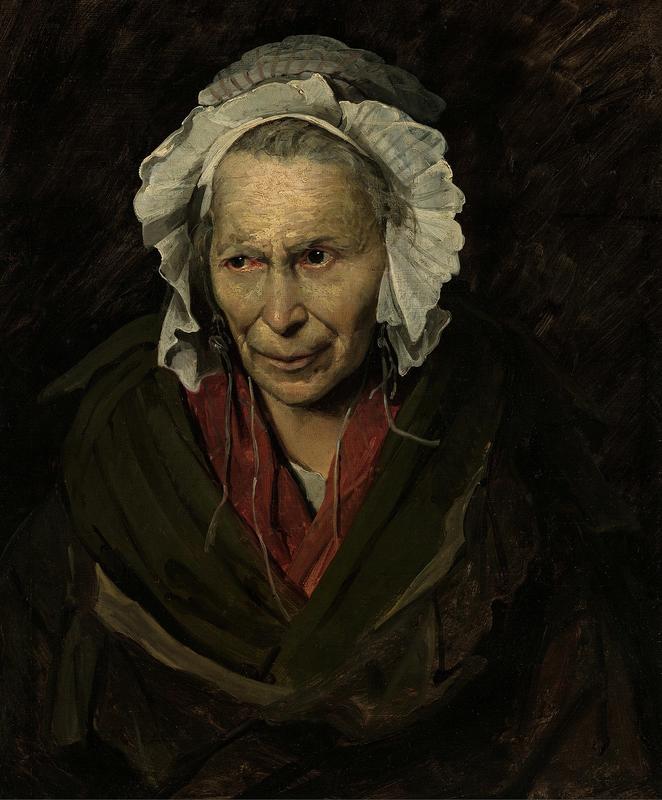More about Portrait of a Woman Suffering from Obsessive Envy

Contributor
When the system kills originality and eliminates the strange, Théodore Géricault goes against the flow.
It is safe to say that Théodore Géricault was one of the most prominent and remarkable representatives of the Romantic movement in French painting, along with his buddy Eugène Delacroix. Romanticism is difficult to put in a neat little box, as it spans all branches of culture and arts, and differs from country to country. However, one common defining feature is that it was a response to the modern era of Enlightenment and the Industrial Revolution that put reason on a pedestal, high above nature and emotion. Most importantly for painters like Géricault, the supremacy of reason also came to rule the arts, its main proponent being the Academy.
Géricault despised academic art, calling it unoriginal, boring, and repetitive. Artists were no longer ‘creating’ but merely ‘producing’ copies in service of the well-run business that was academic art, no different from the mechanical production of factory lines. Individuality and originality were lost, but Géricault dedicated his whole life to reviving these values, bringing them alive through his art. He immediately recognized that to escape the hellish circle of academic repetition, he had to look for his subjects elsewhere – among the outcasts of society, in the darkness and the strangeness of the world. That’s what would feed his creative spirit.
Not only did he often study (and paint) the dead bodies or severed heads and limbs of inmates, resulting in pretty gruesome paintings like his famous Raft of the Medusa (1819), he also turned to the insane for inspiration. This is when his friend Étienne Jean Georget from La Salpêtrière mental hospital comes into the picture. He commissioned Géricault to paint portraits of ten of his patients, each suffering from a different mental illness. Five are lost, but among the five survivors is Woman Suffering from Obsessive Envy (La monomane de l’envie). Georget wanted these portraits for ‘scientific purposes’ – to record the visible effects of the malady on the patient’s appearance, which is really a semi-fake science called physiognomy. You see, folks in the nineteenth century really thought they could tell that someone was insane, or a criminal, by just looking at them.
Géricault took the job, but he couldn’t care less about the ‘scientific’ objective of the portraits. After all, he was literally opposed to such a logical approach to art. Thus, the way he painted the insane is sensitive and empathetic. In the case of this portrait, apart from the bewildered gaze and the twisted mouth, we can barely make out that there is something wrong with the woman. She looks human, with a tortured soul, rather than an inhumane monster, as the mentally ill were perceived by the society. Géricault achieved this intimacy by placing the figure in an undefined space – a dark background – excluding details that could point to a hospital or other patients, unlike what Francisco Goya did in The Madhouse (1814).
In fact, Géricault avoided Goya’s sensationalizing depiction of mental illness, where the figures’ features are purposefully exaggerated to make them look really insane. Goya wasn’t the only one ‘guilty’ of this; it was a general Romantic tendency. The Romantic painters did not, however, do it with malicious intent. Rather, they were fascinated by the ‘purity’ and the ‘freedom’ of the mind of a madman, a mind that was not limited by the rules of modern society. In fact, Gericault treated his subjects almost royally – they are painted in a three-quarter view from the bust up, which was typical for official royal and noble portraits, like those by Sir Joshua Reynlonds.
This series might also be a slight poke at the Academy that Géricault hated so much; sort of a ‘Hey, I’m going to paint crazy people that you push to the edge of society just like you paint the king. Ha!’ statement. It's too bad he died so young; he could have fought against the evil Academy a bit longer, leaving us with more emotive art to admire.
Sources
- Eisenhauer, Jennifer. “A Visual Culture of Stigma: Critically Examining Representations of Mental Illness.” Art Education 61, no. 5, 2008, pp. 13–18. URL = http://www.jstor.org/stable/20694752.
- French painting 1774–1830: the Age of Revolution. New York; Detroit: The Metropolitan Museum of Art; The Detroit Institute of Arts; Wayne State University Press, 1975.
- Géricault, Théodore. ‘Genius and Academies’ in Art in Theory 1815-1900: An Anthology of Changing Ideas. Editors: Charles Harrison et. al., Oxford: Blackwell Publishing Ltd, 1998.
- Miller, Margaret. “Géricault’s Paintings of the Insane.” Journal of the Warburg and Courtauld Institutes 4, no. 3/4, 1941, pp. 151–63. URL = https://doi.org/10.2307/750413.
- Patrick Noon: Crossing the Channel, page 162. Tate Publishing Ltd, 2003.
Featured Content
Here is what Wikipedia says about Monomaniac of Envy
Monomaniac of Envy (Monomane de l’envie), also known by the name of Hyena of Salpêtrière, Portrait of a Woman Suffering from Obsessive Envy, and Manic Envy, is an oil-on-canvas painting by the French Romantic artist Théodore Géricault. Painted as part of his series of ten portraits on the mentally ill, it is one of only five known to survive today. It is currently housed in the Musée des Beaux-Arts de Lyon, France.
Check out the full Wikipedia article about Monomaniac of Envy












